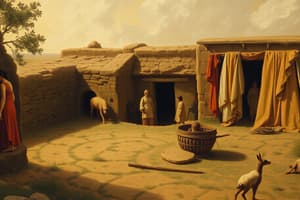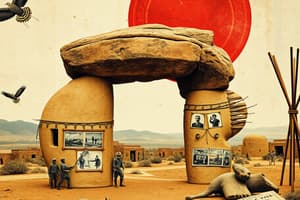Podcast
Questions and Answers
The Clovis people were known for using distinct tools called ______ points.
The Clovis people were known for using distinct tools called ______ points.
Clovis
Clovis culture spread across North America in less than a ______ years.
Clovis culture spread across North America in less than a ______ years.
thousand
The Clovis people lived in crude shelters and were ______ by nature.
The Clovis people lived in crude shelters and were ______ by nature.
nomadic
The Clovis site at Blackwater Draw shows that they lived in the area for about ______ years.
The Clovis site at Blackwater Draw shows that they lived in the area for about ______ years.
The end of the Clovis age occurred approximately ______ years ago.
The end of the Clovis age occurred approximately ______ years ago.
Cowboy George McJunkin discovered large bison bones after a ______ in northern New Mexico.
Cowboy George McJunkin discovered large bison bones after a ______ in northern New Mexico.
James Ridgely Whiteman was an amateur archeologist from ______ in eastern New Mexico.
James Ridgely Whiteman was an amateur archeologist from ______ in eastern New Mexico.
The Clovis people are believed to have occupied the Americas around ______ years ago.
The Clovis people are believed to have occupied the Americas around ______ years ago.
The Clovis culture challenges previous theories about the timing of human ______ to North America.
The Clovis culture challenges previous theories about the timing of human ______ to North America.
Artifacts found at the Blackwater Draw site include advanced spear points and evidence of hunting ______.
Artifacts found at the Blackwater Draw site include advanced spear points and evidence of hunting ______.
The traditional model suggests migration over the Bering land bridge around ______ years ago.
The traditional model suggests migration over the Bering land bridge around ______ years ago.
The Bering land bridge connected ______ to North America.
The Bering land bridge connected ______ to North America.
Evidence from Meadowcroft Rock Shelter suggests human habitation in the Americas dated back to ______ years.
Evidence from Meadowcroft Rock Shelter suggests human habitation in the Americas dated back to ______ years.
Cactus Hill in Virginia has been dated back to ______ years.
Cactus Hill in Virginia has been dated back to ______ years.
Archaeological findings in Lake Mungo, Australia, suggest human presence at least ______ years ago.
Archaeological findings in Lake Mungo, Australia, suggest human presence at least ______ years ago.
Ancient peoples could have traveled coastal routes using ______ from Siberia to Alaska.
Ancient peoples could have traveled coastal routes using ______ from Siberia to Alaska.
The use of canoes changes the understanding of human ______ in the Americas.
The use of canoes changes the understanding of human ______ in the Americas.
The Clovis First Theory proposed that the migration of early humans occurred through an ice-free ______ in Canada.
The Clovis First Theory proposed that the migration of early humans occurred through an ice-free ______ in Canada.
The archaeological site Monteverde, located in ______, has evidence suggesting human habitation much earlier than the Clovis era.
The archaeological site Monteverde, located in ______, has evidence suggesting human habitation much earlier than the Clovis era.
Underwater ancient coastlines may hold some of the oldest Native American ______.
Underwater ancient coastlines may hold some of the oldest Native American ______.
Flashcards are hidden until you start studying
Study Notes
Discovery of the Clovis People
- In 1908, a flood in northern New Mexico exposed ancient bison bones, leading to significant archaeological interest.
- Amateur archaeologist James Ridgely Whiteman discovered fluted points with mammoth bones in 1929 at Blackwater Draw, marking a pivotal site in human history.
- Excavations began in 1932, revealing ancient spearheads, stone tools, and evidence of human occupation dating back 13,000 years.
Clovis Culture and Early Settlement
- Clovis culture suggests early Americans migrated from Siberia to Alaska via a land bridge, later moving south through an ice-free corridor after the last Ice Age.
- Research indicates pre-Clovis people may have arrived in the Americas as far back as 20,000 years ago, challenging the notion of Clovis as the first Americans.
Big Game Hunting and Lifestyle
- The Clovis people thrived in environments populated by large animals like mammoths, giant bison, and saber-toothed tigers.
- Artifacts found at the kill sites demonstrate advanced hunting techniques with projectile points that exhibit signs of use against large game.
- Clovis diet included a diverse range of animals, and they also gathered seeds, nuts, and roots, indicating opportunistic foraging.
Tools and Technology
- Clovis tools include scrapers, drills, blades, and fluted spear points known as Clovis points, finely crafted from materials like flint and obsidian.
- Over 10,000 Clovis points have been discovered across North America, dating back around 13,500 years, signifying a widespread cultural phenomenon.
- The efficient toolkit of the Clovis people enabled quick processing of large game.
Social Structure and Habitation
- Although primarily nomadic, Clovis people established campsites and engaged in seasonal migrations based on food availability.
- Evidence from Blackwater Draw indicates habitation for about 600 years, with the construction of the earliest known water control system in North America.
- Limited knowledge exists about their social structures, diet, clothing, and beliefs, with only one burial of an infant discovered in Montana linked to modern Native American ancestry.
Extinction and Cultural Evolution
- The Clovis culture ended around 12,900 years ago, likely due to climate changes and the extinction of large fauna.
- Adaptation to changing environments resulted in the emergence of post-Clovis cultures, including Folsom in New Mexico.
- Innovations such as improved spear points and atlatls facilitated continued survival and hunting practices beyond the Clovis period, influencing subsequent Native American cultures.
Arrival of the First People in the Americas
- Evolving archaeological interpretations of the first Americans' arrival show new evidence challenging traditional views.
- The migration model suggests humans crossed the Bering land bridge approximately 13,000 years ago, coinciding with the last glacial period's end.
Geological Context
- The Bering land bridge linked Asia and North America, facilitating the migration of various life forms.
- At the last glacial period's conclusion, large glaciers covered most of modern Canada and the northern United States, shaping the landscape significantly.
Clovis First Theory
- Named after Clovis, New Mexico, where distinctive spear points indicate early Native American presence.
- Suggests that migration pathways were limited to the Bering land bridge and an ice-free corridor in Canada.
- Proposes first migrations to the Americas occurred around 13,000 years ago under favorable conditions.
Counterarguments to Clovis First Theory
- Meadowcroft Rock Shelter in Pennsylvania provides evidence of human habitation dating back 19,000 years.
- Cactus Hill in Virginia is dated to 15,000 years, indicating earlier settlements.
- Sites in Monteverde, Chile, and Pedro Ferrada, Brazil, suggest human presence in the Americas over 30,000 years ago.
Comparison with Australian Evidence
- Lake Mungo in Australia shows human presence as far back as 40,000 years, hinting at advanced boat technology and long-distance sea travel.
- Suggests that similar migration patterns by sea could have occurred in the Americas, indicating complex early maritime capabilities.
Implications for Migration Theories
- Canoes may have enabled ancient peoples to navigate coastal routes from Siberia to Alaska and along the west coast of the Americas.
- Coastal migration would enhance access to marine resources and facilitate quicker population dispersals.
- Underwater ancient coastlines may harbor some of the oldest Native American sites, helping explain the early habitation dates.
Reevaluating Initial Occupation Dates
- Potential early boat technology indicates humans may have been in the Americas for at least 20,000 to 25,000 years.
- This challenges previous beliefs that migration relied solely on an ice-free corridor, suggesting alternative travel routes were utilized.
Studying That Suits You
Use AI to generate personalized quizzes and flashcards to suit your learning preferences.



